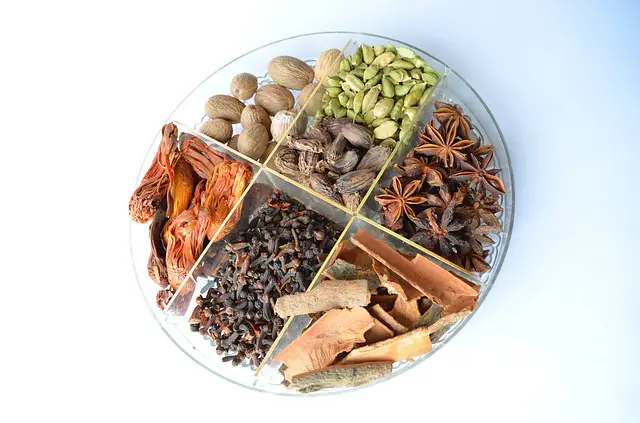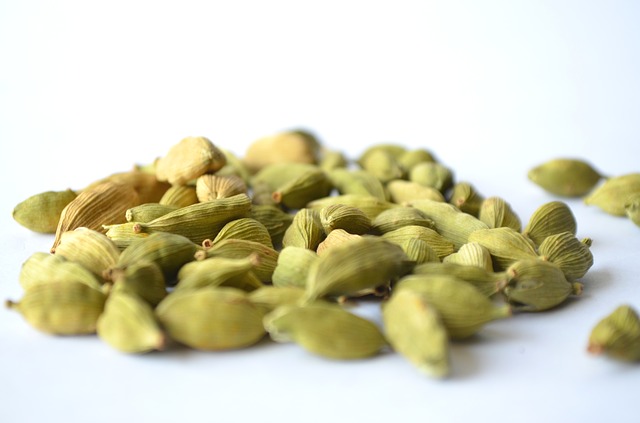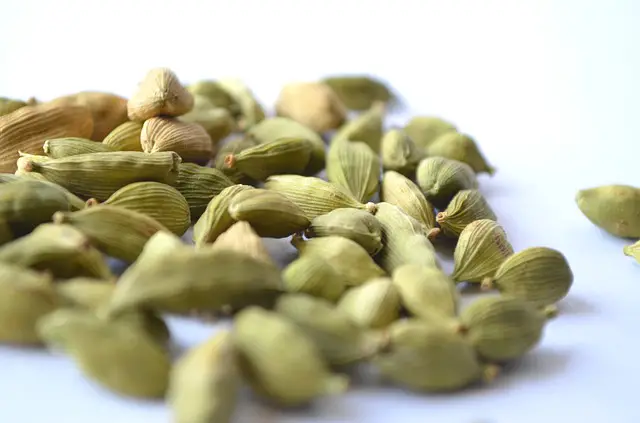What's On This Page
Cardamom Essential Oil
Cardamom is a plant species that produces olives. The olives of this plant are highly valued as a spice and flavouring in various cuisines, especially in Indian cuisine. They are also important for traditional medicine and are used as a remedy in India, Egypt, Persia, Assyria and Rome. In addition to culinary uses such as chai tea, cardamom is an ingredient in Ayurvedic and traditional Chinese medicine.
Cardamom essential oil is extracted from the plant Elettaria cardamomum. This oil, also known as cardamom, grows wild in India, Sri Lanka and Burma. The plant thrives in the tropical climate of India and has a strong aroma with floral overtones and a hint of lemon. The seeds are green when harvested but turn brown when dried due to oxidation. The main chemical compounds found in these essential oils are alpha-pinene, sabinene, borneol, limonene and myrcene.

Cardamom Essential Oil History
The essential oil of cardamom has been used since ancient times, and in the modern era, it has enjoyed great popularity as a spice. It is believed that the Egyptians used it in their mummification rituals along with lavender. In China, this herb was first mentioned in a document during the Yuan Dynasty (1271-1368 A.D.) and remained one of the most popular spices in Asian cuisine.
In India, cardamom has been used for centuries and was first mentioned in the Sanskrit text Atharvaveda (c.1000 B.C.). This herb is also mentioned in the Charaka Samhita, a classic of Ayurveda, one of the most important medical texts written around 3000 years ago. The Greeks were also very fond of this spice, which remains an important ingredient in Greek cuisine and is widely used in European and American cuisine.

The Egyptians used it in their mummification rituals along with lavender. In China, this herb was first mentioned in a document during the Yuan Dynasty (1271-1368 AD) and remained one of the most popular spices in Asian cuisine.
Modern Uses [of Cardamom Essential Oil] The main constituents of this essential oil are linalool and beta-caryophyllene, accounting for over 60% of its composition. Linalool is one of the ten components of the famed eugenol, which has antimicrobial, antifungal, and anticancer properties. Sabinene is another main constituent of this essential oil. It has shown significant anti-bacterial effects and is a rich source of polyunsaturated fatty acids.
Cardamom Essential Oil Characterization
Cardamom essential oil has a fresh herbaceous aroma with hints of lemon. Its aroma is very similar to say that of cinnamon. This oil is light green in the laboratory, with an acid value of 8.16 g/100g and a peroxide value (PV) of 1.45mg/100g. This essential oil is soluble in water and ethanol but insoluble in oils and fats, while its flash point is 68°C at 0.1mmHg.
Essential Oil Properties
Balance, Clarity, and Rejuvenation of the Mind; this essential oil restores positive energy and boosts memory. It also aids in promoting a good night’s sleep. Cardamom Essential Oil is also said to relieve stress, improve concentration, relieve insomnia, and help treat depression. Some users use it as a mood elevator for people dealing with depression or anxiety by diffusing it into their bedrooms at night.
Cardamom Essential Oil Benefits
Promotes a positive mood and feelings of well-being. Aids in the relief of stress promote sleep. Helps with depression and anxiety. A lot of research also says that it can help fight cancer, regulate blood sugar levels, aid in digestion, treat arthritis, etc. It just has so many benefits that you shouldn’t overlook it.

This oil also has strong antiseptic, antimicrobial and antioxidant properties. Also, this essential oil is very effective in treating cold sores and fungal infections. It has a calming effect on the mind as well as promoting relaxation. You can use this oil in massage or body care products or as an aromatherapy aid. Combine it with lavender or other essential oils to create wonderful aromas.
Cardamom Essential Oil Uses
In Ayurveda, a traditional medicine system in India, this oil is used for its anti-inflammatory, antispasmodic, and sedative properties. It is also used in aromatherapy as well as massage therapy. This essential oil is widely used as a flavouring in many food products. In addition, this essential oil is believed to have many health benefits and is widely used by traditional Chinese herbalists.
In beauty care, this essential oil is often used as a fragrant agent in products like soaps, lotions, and perfumes. It gives an exotic feel to the products and relaxes the mind with its strong aroma. This fragrance oil is often found in lip balms, lotions, massage oils, and candles. It has also been known for its therapeutic effects on the skin.
Essential Oil Uses and Benefits of Cardamom Essential Oil (Elettaria cardamomum).
It is useful for:
- Arthritis
- Asthma
- Dermatitis
- Diabetes
- Eczema, psoriasis, and other skin conditions (often combined with other oils to enhance the benefits)
- Hair loss (as a natural conditioner)
- Heartburn and indigestion (use in recipes such as vegetable or fruit broths or as a spice added to soups/stews/salads)
- Insomnia (use in recipes such as vegetable or fruit broths or as a spice added to soups/stews.
- Bacterial Infections
- Bronchitis
- Colds and Flus
- Diaper Rash
- Digestive Disorders (Colitis, IBS, Crohn’s Disease) Can help with inflammation.
How it tastes
Cardamom essential oil has a warm, spicy-sweet taste.
Potential side effects of Cardamom Essential Oil:
It may irritate sensitive skin and mucous membranes. Avoid using on skin that is broken or irritated. Use cautiously if pregnant or breastfeeding, with diabetes, high blood pressure, or if you have any other serious medical conditions. Stop using if you have any allergic reactions to the oil.
Warning: In some countries, essential oil may be restricted or illegal to use or possess. If you are unsure about this oil’s legality in your area, it is best to contact a local essential oil supplier to purchase it for personal use.
If you want more information regarding the uses and benefits of Cardamom Essential Oil, please read our page entitled “How can I use essential oils?” which explains how you can safely and thoroughly dilute and apply essential oils with true therapeutic results.
How it smells
Cardamom essential oil has the aroma of nuts, cloves, ginger, and pine.
Key Actions:
Antioxidant. Cardamom essential oil has antioxidant properties that support cellular health. It may also support joint mobility by stimulating joint fluid production and collagen synthesis.
May modulate inflammation and pain pathways. Cardamom essential oil may benefit arthritis conditions through analgesic (pain-relieving), anti-inflammatory, and anti-arthritic properties.
Cardamom essential oil is a culinary spice used in cakes, cookies, doughnuts, pickles, ice cream, and liquors. The dried ripe seeds are often used as a spice called moulu (múlu). Cardamom pods are generally either light green or dark brown.
There are two types of cardamom seeds: green and black. Green cardamom is the lower-priced seed, while black cardamom is the higher-quality seed. The black seeds often mix “Cardamon,” a mix of cloves, ginger, allspice, and nutmeg, with some cassia bark and green cardamon. Black cardamom is the most widely used in Indian cooking.
White Cardamom
Like the black cardamom, the white cardamom seeds are pungent and warm rather than spicy. The white cardamon is often used whole in jaggery preparations and sprinkled over rice dishes as an alternative to black cardamom.
Black
Black Cardamom seeds are firm but also very aromatic. Their larger size, which is 1.5 times the size of green cardamom, makes them difficult to grind down, and they are generally used whole as a spice or in the form of a fine powder. Black cardamom is commonly known as Haldi, garam masala (spice mixture), kalonji (clove), or kar-daman (black). Black cardamom is used in Indian cuisine, both fresh and ground.
The leaves are also used as an ingredient in Ayurvedic medicines.
Cardamom is a well-established medicinal plant whose leaves are considered a diuretic, an expectorant, an antiseptic, and an insect repellent. In ancient Indian traditions, the seeds were taken in boiled milk to purify the blood and tonics.
Health Benefits of Cardamom Essential Oil:
Cardamom essential oil has many potential health benefits due to its high antioxidant properties. The essential oil has been shown to possess anti-inflammatory properties and is good for people with arthritis. It may also help regulate the lungs’ breathing mechanisms and support blood circulation in the veins, benefiting those suffering from high blood pressure and diabetes.
It is also believed to promote relaxation. Hence it is beneficial for those dealing with stress or anxiety.
Cardamom family (Zingiberaceae)
A perennial herbaceous plant is found in India. The essential oil is obtained from the seeds of the plant. Cardamom contains chemicals like limonene, pinene, linalool, eugenol, cineole, and beta-caryophyllene used for various purposes. Cardamom has been shown to protect against cancer in animal studies.
Conclusion
In conclusion, cardamom essential oil is a versatile and valuable addition to your wellness routine. This oil can enhance your physical and mental well-being with its numerous benefits, ranging from anti-inflammatory and antioxidant properties to promoting relaxation and stress relief. Whether used in cooking, aromatherapy or as an ingredient in skin care products, cardamom essential oil offers several ways to improve your overall health. Discover the various uses and enjoy this remarkable oil’s aromatic and therapeutic qualities.
Leave a Reply